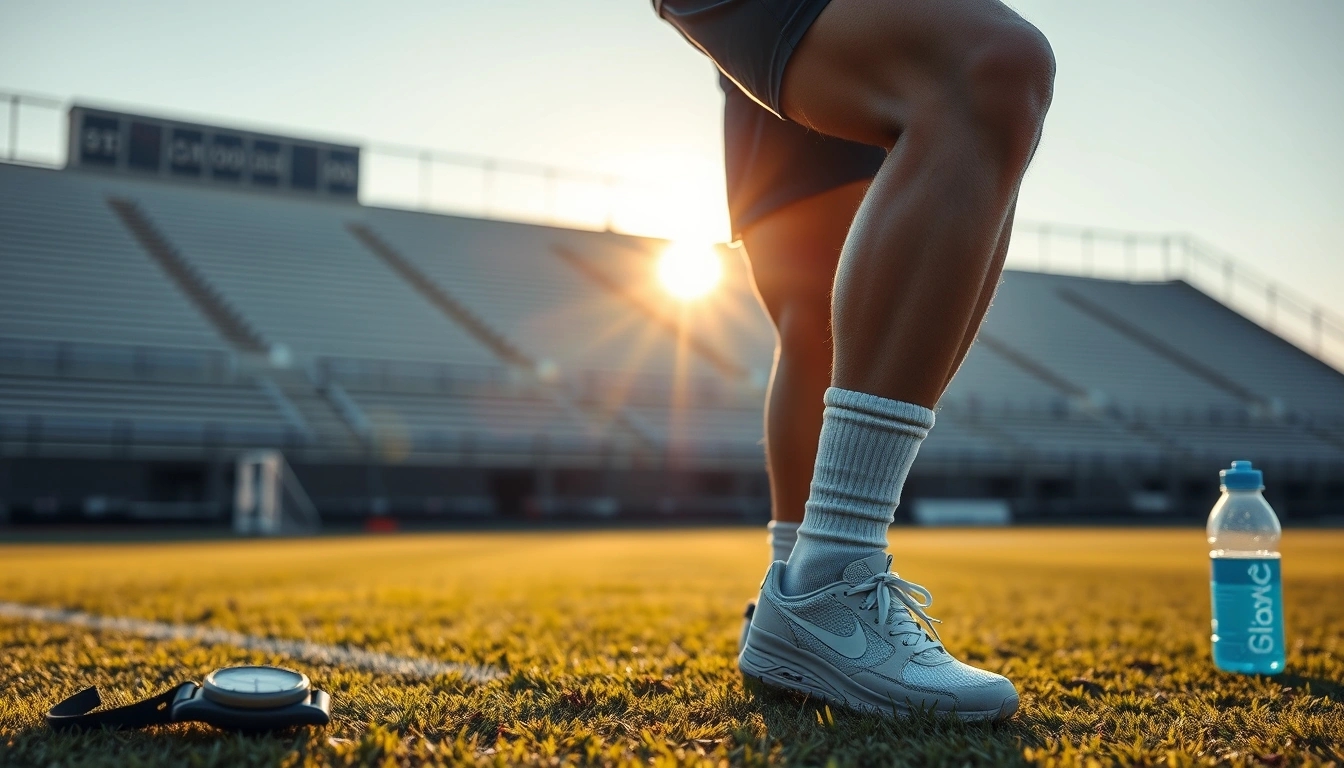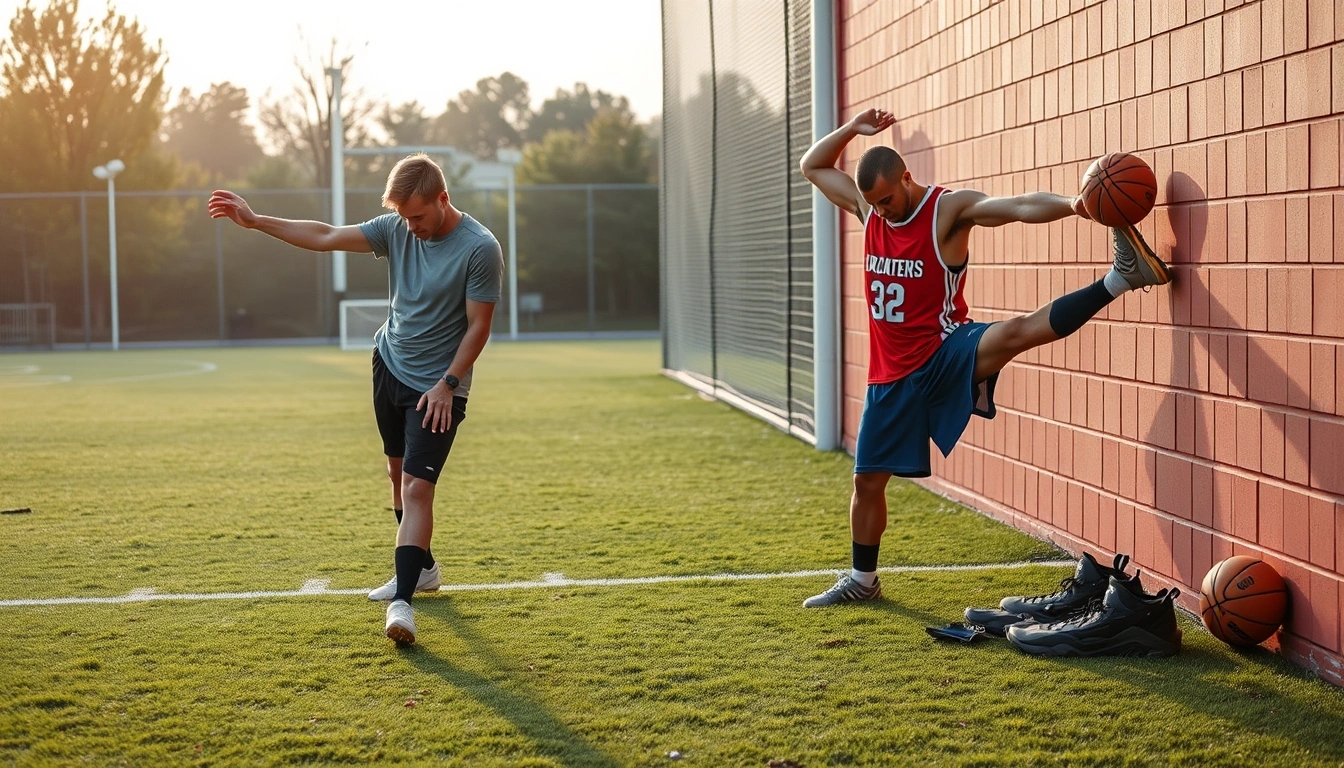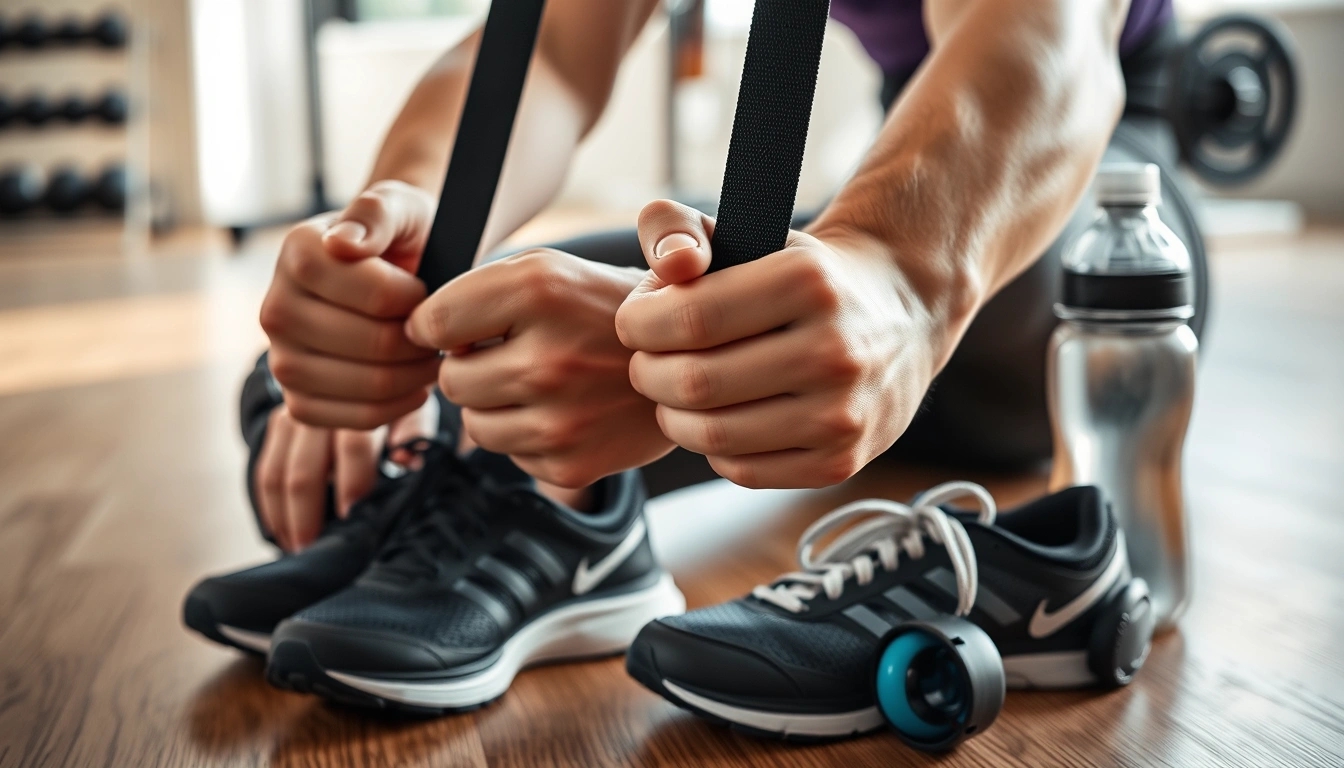Stretching right before any game or practice? Oh, it’s a total game-changer — seriously, it can make or break your whole performance. But hey, don’t just go twisting yourself into a human pretzel and call it a day. There’s a fine art to warming up those muscles, and if you get it wrong, you might as well kiss your agility goodbye. So, buckle up, because we’re diving into the essentials of how to stretch properly before you hit the field, court, or whatever battlefield you call your sport.
First off, let’s get one thing straight: stretching isn’t just about looking flexible or impressing your teammates with a crazy split. It’s about prepping your muscles, tendons, and joints for the chaos you’re about to unleash. Think of it as priming a race car’s engine before the big lap — skip it, and you’re risking a stall or worse, a crash.
- Warm muscles stretch better: Cold muscles are grumpy and stiff, so doing a light jog or some dynamic moves before stretching is key.
- Boosts blood flow: Getting that circulation going means oxygen and nutrients reach your muscles faster, helping them perform better.
- Reduces injury risk: Proper stretching increases flexibility and range of motion, so you’re less likely to pull a muscle or twist an ankle.
Now, here’s where the plot thickens: dynamic vs. static stretching. You’ve probably heard the debate — some swear by moving stretches, others by holding stretches. Let me break it down for you:
| Dynamic Stretching | Static Stretching |
|---|---|
| Involves controlled movements through your range of motion (think leg swings, arm circles). | Involves holding a stretch position for 15-30 seconds (like touching your toes and holding). |
| Prepares muscles for action by mimicking sport-specific movements. | Best used after exercise or during cool-down to improve flexibility. |
| Increases heart rate and warms muscles. | Can temporarily reduce muscle strength if done before intense activity. |
So, before you jump into the game, dynamic stretching is your best buddy. Save the static stretches for after you’ve cooled down — your muscles will thank you.
But hey, don’t rush it! One of the biggest mistakes players make is either rushing through their warm-up or going way overboard with stretches that leave them feeling limp. Here’s a quick checklist of what NOT to do:
- Don’t bounce while stretching — it can cause tiny muscle tears.
- Don’t stretch cold — get your blood pumping first.
- Don’t hold static stretches too long before playing.
- Don’t ignore your body’s signals; pain is a warning, not a challenge.
Quick dynamic warm-up routine to try:
- 30 seconds of high knees- 20 leg swings (each leg)- 20 arm circles (forward and backward)- 10 walking lunges- 30 seconds butt kicks
Give yourself about 8-10 minutes for this warm-up, and you’ll feel the difference. You’ll be more agile, quicker on your feet, and less likely to get sidelined by a dumb injury.
Remember, stretching isn’t just a boring chore; it’s your secret weapon to outplay your opponents and stay in the game longer. So next time you’re about to hit the field, don’t skip the stretch — your future self will thank you.
Why stretching matters before play
Alright, let’s get one thing straight — stretching isn’t just some boring ritual your coach forces you to do before the game. Nope, it’s actually a game-changer. You might’ve heard the old chestnut, “Just touch your toes and you’re good,” but that’s scratching the surface, my friend. Stretching is like the secret sauce that can seriously save you from those nasty injuries and even give your performance a nice little boost. Yeah, it’s that important.
First off, when you stretch properly, you’re waking up your muscles, tendons, and joints — kind of like how you stretch after waking up from a nap, but way more purposeful. This helps increase blood flow, which means more oxygen and nutrients get delivered to your muscles. The result? Your muscles get ready to work hard without throwing a tantrum mid-play. No one wants a cramp or a pulled muscle ruining their highlight reel, right?
- Improved flexibility: This is the biggie. Flexible muscles move better, faster, and with less resistance.
- Better range of motion: Stretching helps your joints loosen up so you can move freely — crucial for dodging, sprinting, or jumping.
- Injury prevention: Tight muscles are like ticking time bombs. Stretch them out and you lower your chances of strains and sprains.
But hold your horses — not all stretching is created equal. Doing a lazy, half-hearted stretch right before the game won’t cut it. You gotta be smart about it. Dynamic stretches — think leg swings, arm circles, and lunges — are your best friends before hitting the field. They mimic the movements you’ll actually do, getting your body prepped and primed. Static stretches, where you hold a position for a while, are better saved for after the game or practice because they can actually decrease your power if done too early.
| Stretch Type | When to Use | Benefits | Potential Downsides |
|---|---|---|---|
| Dynamic Stretching | Before play | Warms muscles, improves mobility, enhances performance | Can cause fatigue if overdone |
| Static Stretching | After play or cool-down | Increases flexibility, aids recovery | May reduce muscle strength if done before activity |
Now, you might be thinking, “Okay, but how long do I stretch?” Well, there’s no magic number, but generally, a 5-10 minute dynamic warm-up is solid. Anything less and you might as well not bother; too much and you risk tiring yourself out before the whistle even blows.
So next time you’re tempted to skip stretching or just half-ass it, remember this: stretching is like insurance for your body. It’s not glamorous, it’s not flashy, but it can save you from sitting on the sidelines nursing an injury. And hey, who doesn’t want to play their best game without the nagging fear of pulling something? Stretch smart, play hard.
Dynamic vs. static stretching: What’s the deal?
Alright, so here’s the scoop on the age-old stretching showdown: dynamic versus static stretching. You’ve probably heard a million times that one is better than the other, or that you should only do one before a game. Well, it’s not that simple. Let’s unravel this knot together and figure out which type of stretch deserves a spot in your pre-game ritual.
First off, dynamic stretching is all about movement. Think leg swings, arm circles, lunges with a twist — basically, stretches where you keep moving, warming up your muscles by mimicking the motions you’ll use in the game. It’s like telling your body, “Hey, get ready, we’re about to move!” This kind of stretching gets your heart rate up, boosts blood flow, and primes your nervous system. If you’re about to sprint, jump, or throw, dynamic stretches are your best buddies.
On the flip side, static stretching means holding a stretch for a period — usually 15 to 60 seconds — like touching your toes and staying there. This type is great for increasing flexibility and calming down muscles after a workout. But here’s the kicker: doing static stretches right before you play can actually make you slower or weaker. Yeah, science backs this up. Holding a stretch cold might reduce muscle power temporarily, which is the last thing you want before a fast-paced game.
| Stretch Type | When to Use | Pros | Cons |
|---|---|---|---|
| Dynamic Stretching | Before games/practice | Increases blood flow, warms muscles, improves performance | Requires proper technique to avoid injury |
| Static Stretching | Post-game or cool-down | Improves flexibility, helps muscle recovery | Can reduce muscle power if done pre-game |
Now, don’t get me wrong — static stretches aren’t the enemy. They’re just misunderstood. If you do them at the wrong time, you might feel sluggish or less explosive. But after the game? They’re like a warm hug for your muscles, helping to reduce soreness and stiffness.
- Pro tip: Start your warm-up with 5-10 minutes of light cardio (jogging, jumping jacks), then dive into dynamic stretches that mimic your sport’s movements.
- Don’t: Hold static stretches before the game — save those for later.
- Remember: Everyone’s body reacts differently. Some players swear by mixing both, but if you’re in a rush, dynamic stretching wins the pre-game battle every time.
Here’s a quick rundown of popular dynamic stretches that can fire you up before hitting the field:
- Leg swings front to back and side to side- Arm circles (small to big)- Walking lunges with a twist- High knees or butt kicks- Hip circles
If you’re still scratching your head wondering if you should hold that hamstring stretch or just swing your leg, think about this: your body needs to be ready to move, not frozen in place. Dynamic stretching wakes your muscles up, static stretching chills them out. So, before game time, keep it moving, keep it light, and save the deep holds for when the whistle blows.
Bottom line? If you want to play like a champ, ditch the static holds pre-game and get your blood pumping with some dynamic moves. Your muscles will thank you, and your coach might just notice you’re a step quicker.

Common mistakes to avoid while stretching
Alright, let’s get real for a second. Stretching before you hit the field or court sounds like a no-brainer, right? But trust me, a ton of players screw it up big time. Either they’re rushing through it like it’s a boring chore or they’re going way overboard, turning their warm-up into some kind of circus contortion act. Neither is good. So, here’s a quick but crucial rundown of what NOT to do when you’re prepping those muscles.
- Don’t rush the process. Skipping or speeding through your stretches is like trying to start a car without warming up the engine. You’re just asking for trouble. Give yourself at least 5-10 minutes to get those muscles loose and ready.
- Avoid overstretching. Feeling that intense pull? That’s your body screaming “slow down!” Pushing too hard can cause micro-tears or even full-blown injuries. Stretch to a point of mild tension, not pain.
- Don’t bounce. Bouncing while you stretch might seem like it helps, but it actually increases your risk of muscle strains. Static holds or smooth, controlled dynamic movements are the way to go.
- Never stretch cold muscles. Jumping straight into static stretches without warming up first is a rookie mistake. Your muscles need to be warm to stretch effectively and safely. Try light jogging or jumping jacks first.
- Don’t hold static stretches too long before activity. Holding a stretch for over 30 seconds before a game can reduce your muscle power and performance. Save those longer holds for after the game or practice.
| Mistake | Why it’s bad | Better approach |
|---|---|---|
| Rushing stretches | Increases injury risk, muscles stay tight | Spend 5-10 mins warming up with dynamic stretches |
| Overstretching | Can cause strains or tears | Stretch to mild tension only |
| Bouncing while stretching | Muscle strain risk goes up | Use slow, steady movements |
| Stretching cold muscles | Less effective, more injury-prone | Warm up first with light cardio |
| Holding static stretches too long pre-game | Decreases muscle power | Save static stretches for post-activity |
Now, if you’re thinking, “Okay, got it, but what about those fancy stretches I see on YouTube that look like yoga meets gymnastics?” Yeah, well, save those for when your body is fully warmed up and you’re not in a hurry to jump into a sprint. The goal here is to prepare, not to impress or show off flexibility skills you don’t have yet.
Here’s a quick do’s and don’ts list to keep handy before your next game:
- Do start with light cardio to get blood flowing.
- Don’t try to push through sharp pain.
- Do focus on dynamic stretches that mimic your sport’s movements.
- Don’t ignore your body’s signals—stop if something feels off.
- Do finish your warm-up with some sport-specific drills.
Remember, stretching isn’t just some boring pre-game ritual—it’s your body’s way of saying “Hey, I’m ready to play!” Screw it up, and you might be sidelined with an injury that could’ve been avoided. Nail it, and you’re setting yourself up for a killer performance. So, take it easy, listen to your muscles, and don’t be that person who’s limping off the field five minutes in because they thought stretching was optional.
In the end, a little patience and common sense go a long way. Your future self (and your coach) will thank you.
Top dynamic stretches for athletes
Okay, so you’re gearing up for the big game, and you know that stretching is part of the deal. But let’s be honest—static stretches that make you feel like a human pretzel before you even start playing? Nah, that’s old news. What you really want are dynamic stretches that get your muscles awake, your blood flowing, and your body ready to jump, sprint, or slam dunk without pulling something nasty. Think of dynamic stretches as your body’s way of saying, “Alright, let’s get this party started!”
- Leg Swings: Front to back or side to side, leg swings are a classic for a reason. They loosen up your hip flexors, hamstrings, and glutes, which are basically the engines for most sports moves. Just hold onto a wall or a buddy (if you trust them) and swing each leg like you’re trying to kick the door open. Aim for 10-15 swings per leg.
- Arm Circles: Don’t underestimate these little circles. Start small and gradually get bigger. They’re fantastic for warming up your shoulders and upper back. Do about 20 seconds clockwise, then switch directions. Bonus: they make you look pretty cool, too.
- Walking Lunges: These bad boys get your quads, hamstrings, glutes, and even your balance all in one go. Take a big step forward, lower your back knee close to the ground without touching, and then step forward with the other leg. Try 10 lunges per side. Warning: may cause slight wobbling if your balance isn’t great.
| Stretch | Duration/Reps | Muscle Groups Targeted |
|---|---|---|
| Leg Swings (Front & Side) | 10-15 per leg | Hip Flexors, Hamstrings, Glutes |
| Arm Circles (Small to Big) | 20 seconds each direction | Shoulders, Upper Back |
| Walking Lunges | 10 per leg | Quads, Hamstrings, Glutes, Balance |
| High Knees | 30 seconds | Hip Flexors, Core, Calves |
| Butt Kicks | 30 seconds | Hamstrings, Calves |
Now, if you think dynamic stretching is just about looking good while flailing your limbs, think again. These moves actually prime your nervous system, so your muscles fire faster and with more coordination. Plus, they increase your range of motion without the risk of overstretching tight muscles like static stretches sometimes do. It’s like revving up a car engine instead of just turning the key and hoping for the best.
Here’s a little secret: mixing in some high knees and butt kicks can seriously crank up your warm-up game. High knees get your heart rate up and activate your core, while butt kicks focus on your hamstrings and calves. Both are simple but effective, and you can sneak them in anywhere—hallway, field, or even your living room if you’re feeling wild.
- High Knees: Run in place, bringing your knees up to waist level. Keep a brisk pace for about 30 seconds.
- Butt Kicks: Jog in place but kick your heels up towards your glutes. You’ll feel your hamstrings waking up in no time.
Pro Tip:Don’t just go through the motions. Focus on controlled, deliberate movements.Quality beats quantity here—better to do fewer perfect reps than a sloppy bunch.
In short, dynamic stretches are your best friend before any athletic activity. They’re quick, effective, and actually fun once you get the hang of them. So next time you’re about to hit the field, court, or track, skip the toe-touching marathon and go for moves that make you feel alive and ready to crush it. Your muscles will thank you, and hey, you might even impress your teammates with your warm-up swagger. Win-win!
Static stretches: When and how to use them
Static stretches: those classic moves where you hold a position and feel that sweet, slow pull in your muscles. They’re the stretching OGs, but here’s the kicker — timing and technique are everything. Just blindly holding a stretch for minutes on end before you hit the field? That’s a rookie mistake. You gotta know when to hold tight and when to cut loose.
Let’s face it, static stretching has its charm. It’s like giving your muscles a gentle reminder, “Hey, don’t get too stiff today.” But doing them at the wrong moment can actually backfire. Ever heard that static stretches before intense activity might reduce your power or speed? Yeah, turns out there’s some truth there. Holding a stretch too long before explosive moves can make your muscles a little too relaxed — not exactly what you want when you’re about to sprint or jump.
- When to use static stretches? Save these for after your workout or game. That’s when your muscles are warm and more receptive. Holding a stretch for 20 to 30 seconds post-play helps improve flexibility and aids recovery.
- How to do them right? Don’t bounce or force it. Slow and steady wins here. Ease into the stretch until you feel tension — not pain — and hold steady. Breathe deep, relax, and don’t rush.
| Moment | Recommended? | Why or Why Not? |
|---|---|---|
| Before intense activity | No | Can reduce muscle power & explosiveness |
| After warm-up (light dynamic movement) | Maybe, but brief | Only if muscles are warm and stretch is gentle |
| Post-exercise | Yes | Helps with flexibility and recovery |
Now, technique — don’t just flop into a stretch like a fish out of water. You want to feel that muscle lengthen, but if you’re grimacing or holding your breath, you’re doing it wrong. A good static stretch should feel like a mild, steady tug. If it hurts, ease off. And here’s a nugget of wisdom: keep your body aligned. Slouching or twisting can mess up the stretch and might even cause injury.
Also, don’t hold your breath! Sounds simple, but you’d be surprised how many folks tense up and stop breathing properly. Deep, calm breaths help your muscles relax and get more oxygen — making the stretch way more effective.
Tips for Effective Static Stretching:- Hold each stretch for 20-30 seconds- Avoid bouncing or jerky movements- Stretch both sides evenly- Stop if you feel sharp pain- Breathe deeply and relax
In the end, static stretches are like that reliable old friend — great when you know how to treat them. Use them wisely after your game or workout to cool down and improve flexibility. But before you start your warm-up, stick to dynamic stretches that get your blood pumping and muscles firing. Remember, stretching isn’t a one-size-fits-all deal; it’s about listening to your body and knowing what it needs when.
So next time you’re tempted to just stand there and hold a stretch for ages before a game, think twice. Timing and technique, folks — that’s the real secret sauce to stretching success.

Stretching routines for different sports
Alright, let’s get real for a second—stretching isn’t a one-size-fits-all kinda deal. A soccer player’s stretch routine? Totally different beast compared to a basketball player’s. You wouldn’t expect a marathon runner to warm up the same way a weightlifter does, right? So, if you’re gearing up for your sport, listen up because tailoring your stretching routine can seriously make or break your game.
- Soccer Players: These guys need explosive leg power and agility. Dynamic stretches like leg swings, high knees, and walking lunges are your best friends here. The focus is on loosening up the hamstrings, quads, calves, and hip flexors because, let’s face it, you’re sprinting, cutting, and kicking non-stop. Static stretches before the game? Nah, save those for after because holding a stretch cold might just suck your power away.
- Basketball Players: Basketball demands quick bursts, lateral movements, and a lot of jumping. So, arm circles, torso twists, and ankle hops get the blood flowing. You’ll want to pay special attention to your calves, calves, calves (did I mention calves?), because those little guys take a beating when you’re bouncing up and down. Also, wrist and shoulder mobility is a must since you’re shooting, passing, and dribbling non-stop.
Now, if you’re scratching your head wondering “What about other sports?”—don’t worry, I got you. Here’s a quick cheat sheet:
| Sport | Key Muscle Groups | Recommended Dynamic Stretches |
|---|---|---|
| Soccer | Hamstrings, Quads, Calves, Hip Flexors | Leg Swings, Walking Lunges, High Knees |
| Basketball | Calves, Shoulders, Wrists, Core | Arm Circles, Torso Twists, Ankle Hops |
| Swimming | Shoulders, Back, Core | Arm Swings, Shoulder Rolls, Torso Rotations |
| Running | Hamstrings, Calves, Glutes | Butt Kicks, High Knees, Leg Swings |
Here’s a little nugget of wisdom: never stretch cold muscles statically. Seriously, it’s like trying to start a car in the dead of winter without warming it up—just ain’t happening smoothly. Instead, get your heart rate up with some light jogging or jumping jacks before diving into those dynamic stretches. Trust me, your muscles will thank you.
And don’t just blindly copy what the pros do. Each body is different. Some players swear by foam rolling before stretching, while others find it’s just a fancy way to waste time. Experiment a bit, see what feels right. The worst thing? Overstretching or rushing through your warm-up. That’s a fast track to injury city.
- Pro tip: Spend 5-10 minutes warming up dynamically, focusing on movements that mimic your sport’s demands.
- Bonus: After the game, static stretches help with muscle recovery and flexibility. So don’t skip the cooldown!
Bottom line—tailor your stretching routine like you tailor your game strategy. Different sports, different needs. And if you ever find yourself wondering whether your warm-up is doing the trick, just ask yourself: “Am I feeling loose and ready, or stiff and awkward?” If it’s the latter, time to rethink your routine.
How long should you stretch?
Stretching before a game or practice isn’t some casual, “let me just touch my toes real quick” kind of deal. Nope, it’s a balancing act – like seasoning your steak; too little, and it’s bland, too much, and you’re ruining the whole thing. So, how long should you really spend on your pre-game stretch? Let’s break it down without getting all preachy.
First off, don’t rush it. You’re not just trying to look cool doing the splits. Your muscles need time to warm up and get ready to perform. But on the flip side, stretching forever? That’s a surefire way to drain your energy before you even step on the field. Trust me, no one wants to be the guy who’s yawning before kickoff because they overdid the warm-up.
| Stretching Type | Recommended Duration | Why? |
|---|---|---|
| Dynamic Stretching | 5-10 minutes | Gets blood flowing, muscles firing, and joints moving without fatigue. |
| Static Stretching | Less than 30 seconds per stretch | Prepares muscles for flexibility; too long can reduce power and speed. |
Now, here’s a little secret: dynamic stretches are your best friend before the game. Think leg swings, arm circles, and lunges with a twist. These get your heart rate up and your muscles ready to explode into action. Spend about 5 to 10 minutes on these, and you’re golden.
Static stretches, where you hold a position, like reaching for your toes and staying there, have their place but mostly after the game or during cool-downs. Doing them too long pre-game can actually slow you down. Yeah, it sounds weird, but holding a stretch for more than 30 seconds can make your muscles less responsive when you need them most.
- Tip #1: Start with light jogging or jumping jacks for 3-5 minutes to get the blood pumping.
- Tip #2: Follow up with dynamic stretches lasting around 5-10 minutes.
- Tip #3: Save static stretches for after the game or during breaks.
If you’re in a hurry and can only squeeze in a quick warm-up, focus on quality over quantity. A few well-executed dynamic stretches can do more good than 20 minutes of half-hearted toe touches. And hey, if you’re the type who likes to go overboard, remember: overstretching can zap your strength and speed. Nobody wants to be the slowpoke on the team because they’re too “loose.”
Stretching Duration Cheat Sheet:--------------------------------- Warm-up jog: 3-5 minutes- Dynamic stretches: 5-10 minutes- Static stretches (pre-game): <30 seconds per stretch- Static stretches (post-game): 30 seconds to 1 minute per stretch
In the end, finding your sweet spot is about listening to your body and knowing your sport. Sprinting sprinters might need shorter, sharper routines, while soccer players or basketball players could benefit from a slightly longer warm-up. So, experiment a bit, but keep it tight and purposeful.
Remember, stretching isn’t just a checkbox on your pre-game list. It’s the secret sauce that can keep you injury-free and firing on all cylinders. Too little? You’re asking for trouble. Too much? You’re asking to be benched. Nail this timing, and you’re already ahead of half the competition.
Stretch smart, play hard, and maybe leave the pretzel poses for yoga class.
Injury prevention through proper stretching
Stretching isn’t just some boring pre-game ritual your coach nags you about—it’s actually your first line of defense against those pesky strains and sprains that can bench you for weeks. Seriously, think of your muscles like rubber bands. If you yank on a cold, stiff band, it snaps. But if you warm it up and stretch it gently? It’s way less likely to go *pop* when you need it most.
Now, here’s the deal: stretching isn’t just about getting flexible enough to touch your toes or do the splits (although, hey, if you can, good for you). It’s about preparing your muscles, tendons, and ligaments to handle the sudden bursts of energy and weird angles your body will face on the field. When you stretch properly, you’re basically telling your body, “Hey, get ready to move, but don’t freak out.”
- Increased blood flow: Stretching pumps more blood into your muscles, which means more oxygen and nutrients. That’s like fueling your engine before a race.
- Improved muscle elasticity: When muscles are elastic, they can stretch and contract without tearing.
- Better joint range of motion: This helps you move more freely and avoid awkward positions that cause injuries.
But here’s where many folks get it wrong: stretching cold muscles is a no-no. Jumping straight into static stretches—where you hold a position for a long time—without warming up first can actually do more harm than good. Your muscles need some movement first, so dynamic stretches (think leg swings, arm circles, or gentle jogging) are the way to go before you hit those static holds.
| Stretch Type | When to Use | Benefit for Injury Prevention |
|---|---|---|
| Dynamic Stretching | Before activity | Warms muscles, increases heart rate, improves mobility |
| Static Stretching | After activity or cool down | Enhances flexibility, reduces muscle tension |
And don’t be fooled into thinking that “more is better” when it comes to stretching. Overstretching can actually weaken muscles and make you more prone to injury. It’s about quality, not quantity. A solid 5-10 minutes of targeted stretching, done right, beats a frantic 30 minutes of careless twisting any day.
Here’s a quick checklist to keep your stretching injury-proof:
- Warm up first: Light jogging or jumping jacks to get blood moving.
- Focus on major muscle groups: Hamstrings, calves, quads, hips, and shoulders.
- Don’t bounce: That jerky movement can cause micro-tears.
- Listen to your body: Stretch to a gentle pull, not pain.
So next time you’re tempted to skip stretching because “meh, it’s boring,” remember: your body’s insurance policy against injury is right there in those stretches. Take the few extra minutes, do it right, and you’ll thank yourself when you’re still on the field while others are limping off.
Stretch smart, stay strong, and keep playing hard.

Stretching myths busted
Alright, let’s get real for a minute. You’ve probably heard all sorts of stuff about stretching before playing sports — some of it true, some of it just plain wrong. Like, “stretching reduces soreness” or “you should stretch cold muscles before warming up.” Well, buckle up because it’s time to separate the wheat from the chaff with some cold, hard truths.
First off, the idea that stretching reduces muscle soreness after a tough workout? Eh, not so much. Studies have shown that while stretching feels nice and might help your muscles relax, it doesn’t actually stop that dreaded post-game stiffness or soreness. So, if you’re stretching hoping to magically erase soreness, you’re barking up the wrong tree. What really helps is proper cool-down, hydration, and maybe a foam roller — but we’ll get to that later.
Now, about stretching cold muscles — this one’s a classic mistake. Jumping straight into static stretching (you know, holding a stretch for a long time) when your muscles are ice cold is like trying to bend a frozen twig. It’s not only ineffective but can actually increase your risk of injury. Instead, you want to warm those muscles up with some light jogging or dynamic movements first.
- Dynamic stretching – Think leg swings, arm circles, lunges with a twist. These get your blood flowing and muscles ready for action.
- Static stretching – Holding a stretch for 20-30 seconds, usually better saved for after your workout or game.
| Myth | Reality |
|---|---|
| Stretching prevents all injuries | Stretching helps flexibility but can’t stop every strain or sprain. Proper warm-up and conditioning are key. |
| Static stretching before exercise is best | Dynamic stretches are better pre-game; static stretching is more effective post-exercise. |
| Stretching instantly improves performance | It can help, but overdoing it or doing it wrong might actually reduce power temporarily. |
Here’s a fun one — some folks swear by “bouncing” in stretches to get deeper. Newsflash: that’s called ballistic stretching, and it’s a fast track to pulled muscles if you’re not careful. Slow and steady wins the race here.
So, what’s the takeaway? Before you hit the field or court, forget about touching your toes while shivering in the cold. Instead, get moving with dynamic stretches that mimic your sport’s motions. Save the long, static holds for after you’ve cooled down — that’s when your muscles are warm and more pliable.
Quick Tips to Bust Stretching Myths:- Don’t stretch cold muscles statically; warm up first.- Dynamic stretching is your pre-game BFF.- Static stretching is great post-game for flexibility.- Stretching won’t cure soreness but helps keep muscles loose.- Avoid bouncing stretches to prevent injuries.
In the end, stretching is a tool — not a magic wand. Use it smartly, and your body will thank you. Misuse it, and you might just end up sidelined with an injury that could’ve been avoided. So next time someone tells you to “just stretch more,” ask them what kind, when, and how. Because, trust me, not all stretches are created equal.
Remember: Stretch smart, play hard, and don’t buy every stretching myth that floats around locker rooms or social media.
Tools and gear to aid your stretching
Alright, let’s get real about the stuff you see all over social media and sports stores claiming to be the holy grail of stretching. Foam rollers, resistance bands, apps—you name it, someone’s selling it as a game changer. But here’s the kicker: not all of these tools are created equal, and some might just be fancy dust collectors in your gym bag. So, what’s worth your hard-earned cash, and what’s just hype? Let’s break it down.
Foam Rollers: These bad boys have become a staple in every athlete’s arsenal, and for good reason. Foam rolling is like giving your muscles a deep tissue massage without the hefty price tag of a pro. It helps release muscle knots, improve blood flow, and can speed up recovery. But beware—if you’re rolling like a maniac without knowing what you’re doing, you might just be inviting pain instead of relief. Pro tip: focus on slow, controlled movements and target tight spots rather than blasting every inch of your body.
| Tool | Pros | Cons | Best Use |
|---|---|---|---|
| Foam Roller | Improves muscle flexibility, aids recovery, affordable | Can cause bruising if used improperly, requires technique | Pre/post workout muscle release |
| Resistance Bands | Portable, versatile, great for dynamic stretching | Quality varies, can snap if cheap | Assisted stretches, strength & flexibility combo |
| Stretching Apps | Guided routines, customizable, motivational | Some require subscriptions, generic advice | Learning new stretches, tracking progress |
Resistance Bands: If you want to add some oomph to your stretches, these stretchy loops might be your new best friend. They’re perfect for dynamic stretches and can help you push your range of motion without risking injury. Plus, they’re super portable, so you can toss them in your bag and stretch anywhere—from the locker room to your living room. Just a heads-up: cheap bands can snap unexpectedly, so invest in quality and always inspect them before use.
Now, about those apps flooding your phone’s app store. Some are genuinely useful, offering tailored routines and reminders to keep you consistent. But others? Well, let’s just say they’re about as helpful as a chocolate teapot. The key is to find one that matches your level and sport, and not just blindly download the top-rated one because it looks shiny.
- Look for apps with: clear instructions, video demos, and customizable plans.
- Avoid apps that: overwhelm you with ads or push expensive gear.
At the end of the day, tools and gear are just that—tools. They won’t magically fix your flexibility or prevent injuries if you’re lazy or sloppy with your stretching. But used right, they can definitely make your warm-up and cool-down sessions more effective and maybe even a little more fun. So, before you splash out on the latest gadget, ask yourself: do I really need this, or am I just chasing the hype?
Quick checklist before buying stretching gear:
- Understand your stretching goals- Research product reviews (not just the flashy ads)- Start simple; master basics before gadgets- Prioritize quality over quantity- Don’t forget proper technique beats any tool
In the end, your body is the real MVP here. Treat it right, stretch smart, and maybe—just maybe—you’ll avoid those “I should’ve stretched” moments on game day.
Stretching tips from pro athletes
Alright, let’s get real for a minute. When you hear “professional athletes,” you probably imagine them crushing world records or dunking like it’s nobody’s business. But what you might *not* realize is how much time they spend on something as seemingly mundane as stretching. Yeah, stretching — that thing most of us half-heartedly do while waiting for the game to start or between Netflix episodes. Spoiler alert: these top-tier athletes swear by very specific stretches, and their routines might just blow your mind (or at least upgrade your warm-up game).
- Dynamic stretches are the real MVPs: Forget those stiff, frozen-in-place moves. Most pros kick off with dynamic stretches — think leg swings, walking lunges, arm circles — basically moves that get the blood pumping and muscles firing. Why? Because it preps the body for the explosive actions ahead without making you feel like a human rubber band about to snap.
- Target the trouble spots: Every sport has its “problem areas.” Basketball players often zero in on their hips and calves, while runners obsess over hamstrings and quads. Pro athletes don’t waste time stretching everything equally; they hone in on what their bodies need most.
- Consistency over craziness: It’s tempting to go all out and hold stretches forever, but many pros keep it simple — short, focused, and consistent. Overstretching before play can actually backfire, making muscles less responsive. Yep, less can be more.
| Pro Athlete | Favorite Stretch | Why They Swear By It |
|---|---|---|
| Serena Williams | Dynamic Hip Openers | Keeps her agile and ready for those quick court sprints |
| LeBron James | Arm Circles & Leg Swings | Warms up his whole body for explosive jumps and passes |
| Usain Bolt | Walking Lunges | Prepares his legs for maximum power and stride length |
Now, here’s a fun fact: not all stretches are created equal, and pros know that. For example, some swear by PNF stretching (proprioceptive neuromuscular facilitation) — which sounds fancy but basically means contracting and relaxing muscles in a controlled way to get way more flexibility. It’s a bit technical, but if you’re serious about your warm-up, it’s worth looking into.
Also, don’t overlook the mental side of things. Stretching isn’t just about loosening muscles; it’s a moment to zone in, shake off distractions, and get your head in the game. Many athletes combine their stretches with breathing exercises or visualization techniques. So next time you’re rolling out those hamstrings, try to focus on your next play, not the guy yelling from the sidelines.
Pro Athlete Stretch Routine Snapshot:- 5 minutes of light jogging or jump rope- 8-10 leg swings (front to back, side to side)- 10 walking lunges with torso twist- 20 arm circles (10 forward, 10 backward)- 30-second dynamic hip openers per leg
Look, if you’re serious about upping your game, borrowing a page from the pros’ playbook can’t hurt. Find those stretches that feel like they actually do something, stick with them, and don’t be afraid to mix in some new moves. Who knows? Your “new favorite warm-up move” might just be a stretch away.
Quick Tip: If you’re ever unsure, video yourself stretching or ask a coach to check your form. You don’t want to end up looking like a pretzel in a bad way. Trust me, proper technique beats fancy moves every time.
So, next time you hit the field or court, remember: stretching isn’t just a chore — it’s your secret weapon. And if it’s good enough for the pros, it’s good enough for you.

Post-game stretching: Why it’s just as important
Alright, so the game’s over, the crowd’s gone wild (or maybe just mildly enthusiastic), and you’re probably itching to just toss your gear in the bag and head straight for the showers. But hold up! Before you bounce, let’s talk about post-game stretching. Yeah, I know, it sounds like one of those boring, “adult” things that nobody really wants to do, but trust me, it’s a game changer for your recovery and future performance.
Here’s the deal: after a hard-fought match or a grueling practice, your muscles are tight, fatigued, and honestly, kind of pissed at you. They’ve been working overtime, contracting and expanding like crazy, and now they’re full of lactic acid and micro-tears. If you just stop moving abruptly, all that tension stays locked in, which can lead to stiffness, soreness, and even injury down the line.
| Why Post-Game Stretching Rocks | What Happens If You Skip It |
|---|---|
| Helps flush out lactic acid and toxins | Muscle cramps and delayed soreness |
| Improves flexibility and range of motion | Stiffness that can last for days |
| Reduces risk of injury in next games | Higher chance of strains or pulls |
| Promotes faster muscle recovery | Longer downtime and fatigue |
| Calms the nervous system and lowers heart rate | Feeling jittery or restless post-game |
Now, I’m not saying you need to stretch for hours like some yoga guru. A simple, focused routine lasting about 10-15 minutes can do wonders. Focus on static stretches here—those slow, steady holds that target the muscles you just used. Think hamstrings, quads, calves, hips, and lower back. Don’t rush it; hold each stretch for 20-30 seconds, and breathe through the discomfort. No bouncing! That’s a rookie mistake.
- Quad stretch: Stand on one leg, pull your other foot to your butt, and feel that front thigh loosen up.
- Hamstring stretch: Sit down, extend one leg, and reach for your toes. Don’t worry if you can’t touch them yet.
- Calf stretch: Lean against a wall with one foot back and heel down—hello, tight calves.
- Hip flexor stretch: Lunge forward gently to open up those hips.
Here’s a quick tip: post-game stretching isn’t just about your body, it’s also about your mind. It’s a moment to decompress, reflect on what went well, and mentally prepare for the next session. Plus, it’s a sneaky way to avoid the dreaded “next-day soreness” that can mess up your week.
So next time you’re tempted to bolt right after the whistle, remember: stretching after the game isn’t a suggestion—it’s part of the hustle. Your muscles will thank you, your future self will thank you, and heck, even your coach might give you a nod of approval (or at least less eye-rolling).
Post-Game Stretching Routine - Sample-------------------------------------1. Light jog or walk - 3 minutes2. Quad stretch - 30 seconds each leg3. Hamstring stretch - 30 seconds each leg4. Calf stretch - 30 seconds each leg5. Hip flexor stretch - 30 seconds each leg6. Lower back twist - 30 seconds each side7. Deep breathing and relaxation - 2 minutes
Remember, skipping post-game stretches is like skipping dessert after a great meal—sure, it’s tempting, but you’re missing out on the full experience. So take those extra minutes, stretch it out, and keep yourself in the game longer. Because let’s face it, the grind never stops, and neither should your care for your body.
Frequently Asked Questions
- Why is stretching important before playing sports?
Stretching warms up your muscles, boosts blood flow, and preps your body for action. Think of it as priming an engine—without it, you risk injury and poor performance. It’s not just about flexibility; it’s about getting your body game-ready.
- What’s the difference between dynamic and static stretching?
Dynamic stretches involve movement—like leg swings or arm circles—that get your muscles firing and your heart rate up. Static stretches are those held positions, like touching your toes, which are better saved for after your activity. Before playing, dynamic stretching is your best friend.
- Can I overstretch before a game?
Absolutely, and it’s a common mistake! Overstretching can weaken muscles and reduce power. Keep your pre-game stretches controlled and avoid pushing to the point of pain. Remember, it’s about warming up, not turning into a human rubber band.
- How long should I spend stretching before playing?
The sweet spot is usually 5 to 10 minutes of dynamic stretching. Too little won’t prepare you, and too much might tire you out. Tailor it to your sport and body, but keep it efficient and focused.
- Do stretching routines differ between sports?
Yes! A soccer player’s warm-up will focus more on leg mobility and explosive moves, while a basketball player might emphasize agility and arm flexibility. Customize your stretches to the demands of your sport for maximum benefit.
- Is post-game stretching really necessary?
Definitely. Post-game stretches help your muscles cool down, reduce soreness, and speed up recovery. Skipping this step is like slamming the brakes without easing off the gas—your body will thank you later.
- Are foam rollers and resistance bands worth using for stretching?
They can be game-changers! Foam rollers release muscle knots and improve flexibility, while resistance bands add controlled tension for deeper stretches. Just make sure you use them correctly to avoid injury.
- What are common stretching mistakes to avoid?
Rushing through stretches, bouncing during static stretches, and stretching cold muscles are big no-nos. Take your time, warm up with light activity first, and hold static stretches gently after playing.
- Does stretching reduce muscle soreness?
This one’s a myth. Stretching alone won’t prevent soreness after intense exercise, but it can improve flexibility and circulation, which may help your overall recovery process.
- How do professional athletes approach stretching?
Pros treat stretching like a ritual—consistent, sport-specific, and balanced between dynamic warm-ups and static cool-downs. They often incorporate tools and listen closely to their bodies, making stretching a key part of their success formula.













